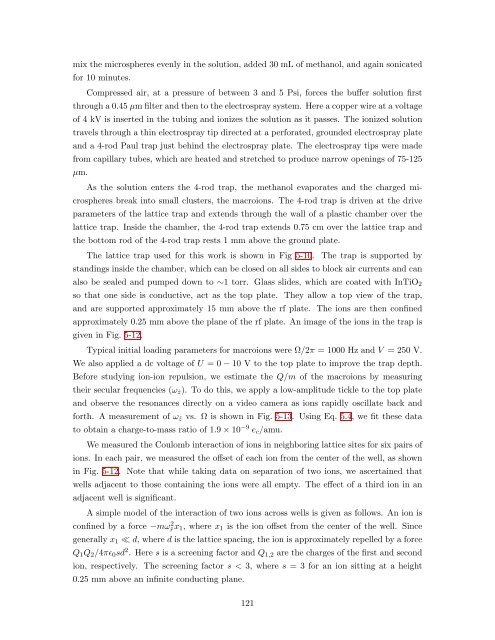Ph.D. Thesis - Physics
Ph.D. Thesis - Physics
Ph.D. Thesis - Physics
Create successful ePaper yourself
Turn your PDF publications into a flip-book with our unique Google optimized e-Paper software.
mix the microspheres evenly in the solution, added 30 mL of methanol, and again sonicated<br />
for 10 minutes.<br />
Compressed air, at a pressure of between 3 and 5 Psi, forces the buffer solution first<br />
through a 0.45 µm filter and then to the electrospray system. Here a copper wire at a voltage<br />
of 4 kV is inserted in the tubing and ionizes the solution as it passes. The ionized solution<br />
travels through a thin electrospray tip directed at a perforated, grounded electrospray plate<br />
and a 4-rod Paul trap just behind the electrospray plate. The electrospray tips were made<br />
from capillary tubes, which are heated and stretched to produce narrow openings of 75-125<br />
µm.<br />
As the solution enters the 4-rod trap, the methanol evaporates and the charged mi-<br />
crospheres break into small clusters, the macroions. The 4-rod trap is driven at the drive<br />
parameters of the lattice trap and extends through the wall of a plastic chamber over the<br />
lattice trap. Inside the chamber, the 4-rod trap extends 0.75 cm over the lattice trap and<br />
the bottom rod of the 4-rod trap rests 1 mm above the ground plate.<br />
The lattice trap used for this work is shown in Fig 5-10. The trap is supported by<br />
standings inside the chamber, which can be closed on all sides to block air currents and can<br />
also be sealed and pumped down to ∼1 torr. Glass slides, which are coated with InTiO2<br />
so that one side is conductive, act as the top plate. They allow a top view of the trap,<br />
and are supported approximately 15 mm above the rf plate. The ions are then confined<br />
approximately 0.25 mm above the plane of the rf plate. An image of the ions in the trap is<br />
given in Fig. 5-12.<br />
Typical initial loading parameters for macroions were Ω/2π = 1000 Hz and V = 250 V.<br />
We also applied a dc voltage of U = 0 − 10 V to the top plate to improve the trap depth.<br />
Before studying ion-ion repulsion, we estimate the Q/m of the macroions by measuring<br />
their secular frequencies (ωˆz). To do this, we apply a low-amplitude tickle to the top plate<br />
and observe the resonances directly on a video camera as ions rapidly oscillate back and<br />
forth. A measurement of ωˆz vs. Ω is shown in Fig. 5-13. Using Eq. 5.4, we fit these data<br />
to obtain a charge-to-mass ratio of 1.9 × 10 −9 ec/amu.<br />
We measured the Coulomb interaction of ions in neighboring lattice sites for six pairs of<br />
ions. In each pair, we measured the offset of each ion from the center of the well, as shown<br />
in Fig. 5-12. Note that while taking data on separation of two ions, we ascertained that<br />
wells adjacent to those containing the ions were all empty. The effect of a third ion in an<br />
adjacent well is significant.<br />
A simple model of the interaction of two ions across wells is given as follows. An ion is<br />
confined by a force −mω 2 ˆr x1, where x1 is the ion offset from the center of the well. Since<br />
generally x1 ≪ d, where d is the lattice spacing, the ion is approximately repelled by a force<br />
Q1Q2/4πǫ0sd 2 . Here s is a screening factor and Q1,2 are the charges of the first and second<br />
ion, respectively. The screening factor s < 3, where s = 3 for an ion sitting at a height<br />
0.25 mm above an infinite conducting plane.<br />
121
















